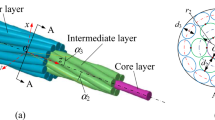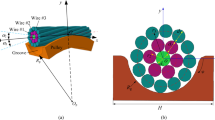Abstract
The mechanical behaviour of cables and ropes used in engineering applications, though studied for the past three decades, varies widely depending on the numerical models adopted. Though these models predict the global response reasonably well, they differ widely in modelling the local contact conditions, the frictional effects at the interfaces and predicting the loss of stiffness of the cable assemblies. Three modes of contact can exist among the wires in a stranded cable assembly, i.e. the contact among the wires in the same layer (known as hoop or lateral contact), the contact among the wires in adjoining layers (radial contact) and the combined contact of all the wires (combined lateral and radial contact). The cables are hitherto modelled on the assumption of the presence of one of the contact modes only, though in reality the contact of modes change from one to the other, depending on the loading and the nature of contraction of the wires. The behaviour of the cable can be well understood if the appropriate mode of contact prevalent at every stage of loading is adopted in the model. This paper analyses the contact modes present in a single layer cable assembly and considers its response under an axial tensile load and an axial twisting moment. Based on the initial geometry, the contact mode is determined and depending on successive loading, the contraction of all the wires in the radial and lateral directions are ascertained and the threshold limits at which the contact modes change from one to the other are established. The overall response of the cables under the cascading effects of the presence of different contact modes, is compared with the works of the other authors who have adopted one type of contact mode only during their study. This has resulted in an overall reduction in the stiffness of the cable assembly, compared to the existing models. The force and moments in the individual wires are studied and the contact forces and the resulting contact stresses are established as a function of applied loads. The effect of the friction and the associated slip of the wires have been included. Apart from consideration of the radial contraction of the wires due to the Poisson effect, as accounted by few authors, this paper considers the radial deformation due to contact forces, as a special feature. This has resulted in refined expressions for the curvatures and twist of the wire and the associated forces in the normal and binormal directions. The predictions with these inclusions are compared with the existing works and the importance of the refinements to the cable designers are highlighted.








Similar content being viewed by others
References
Bert, C.W., Stein, R.A.: Stress analysis of wire rope in tension and torsion—Part I, II. Wire Wire prod. 36, 621–624, 769–816 (1962)
Costello, G.A., Phillips, J.W.: A more exact theory for twisted wire cables. J. Eng Mech. 100, 1096–1099 (1974)
Costello, G.A., Phillips, J.W.: Effective modulus of twisted wire cables. J. Eng. Mech. 102, 171–181 (1976)
Costello, G.A.: Theory of wire rope. Springer, New York (1990)
Cardou, A., Jolicoeur, C.: Mechanical models of helical strands. Appl. Mech. Rev. 50(1), 1–14 (1997)
Ghoreishi, S.R., Cartraud, P., Davies, P., Messager, T.: Validity and limitations of linear analytical models for steel wire strands under axial loading using a 3D FE model. Int. J. Solids Struct. 44, 2924–2942 (2007)
Gnanavel, B.K., Gopinath, D., Parthasarathy, N.S.: Effect of friction on coupled contact in a twisted wire cable. J. Appl. Mech. 77, 1–6 (2010)
Gnanavel, B.K., Parthasarathy, N.S.: Effect of interfacial contact forces in radial contact wire strand. Arch. Appl. Mech. 81, 303–317 (2011)
Hruska, F.H.: Tangential forces in wire ropes. Wire Wire Prod 28, 455–460 (1953)
Huang, N.C.: Finite extension of an elastic strand with a centre core. J. Appl. Mech. 45, 852–858 (1978)
Knapp, R.H.: Derivation of a new stiffness matrix for helically armored cables considering tension and torsion. Int. J. Numer. Meth. Eng. 14, 515–529 (1979)
Kumar, K., Cochran, J.E., Cutchins, J.A.: Contact stresses in cable due to tension and torsion. J. Appl. Mech. 64, 935–939 (1997)
Love, A.E.H.: A treatise on the mathematical theory of elasticity. Dover Publishers, New York (1944)
Machida, S., Durelli, A.J.: Response of a strand to axial and torsional displacements. J. Mech. Eng. Sci. 15(4), 241–251 (1973)
McConnell, K.G., Zemke, W.P.: A model to predict the coupled axial torsion properties of ACSR electrical conductors. Exp. Mech. 25–30, 237–244 (1982)
Parthasarathy, N.S.: Effective stiffness and slip—damping of stranded cables, Ph.D. Thesis, University of Visveswaraya College of Engineering, Bangalore University, Bangalore, India (1998)
Phillips, J.W., Costello, G.A.: Contact stresses in twisted wire cables. J. Eng. Mech. 99, 331–341 (1973)
Ramsey, H.: Theory of thin rods with application to helical constituent wires in cables. Int. J. Mech. Sci. 30, 559–570 (1988)
Ramsey, H.: Analysis of interwire friction in multilayered cable under uniform extension and twisting. Int. J. Mech. Sci. 32(8), 709–716 (1990)
Sathikh, S., Moorthy, M.B.K., Krishnan, M.: A Symmetric linear elastic model for helical wire strands under axisymmetric loads. J. Strain Anal. 31, 389–399 (1996)
Utting, W.S., Jones, N.: Tensile testing of a wire rope strand. J. Strain Anal. 20, 151–164 (1985)
Utting, W.S., Jones, N.: The response of wire rope strands to axial tensile loads - Part I, Experimental results and theoretical predictions - Part II, Comparison of experimental results and theoretical predictions. Int. J. Mech. Sci. 29, 605–619, 621–636 (1987)
Wempner, G.: Mechanics of solids with applications to thin bodies. Sijthoff and Noordhoff, (1981)
Author information
Authors and Affiliations
Corresponding author
Rights and permissions
About this article
Cite this article
Gnanavel, B.K., Parthasarathy, N.S. Effect of interfacial contact forces in single layer cable assemblies. Int J Mech Mater Des 8, 183–195 (2012). https://doi.org/10.1007/s10999-012-9185-7
Received:
Accepted:
Published:
Issue Date:
DOI: https://doi.org/10.1007/s10999-012-9185-7




